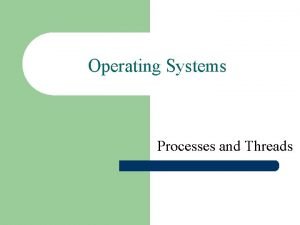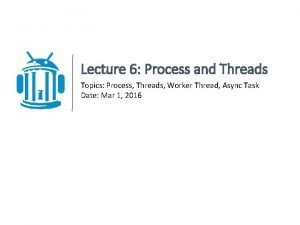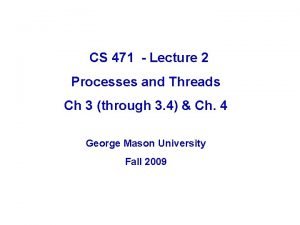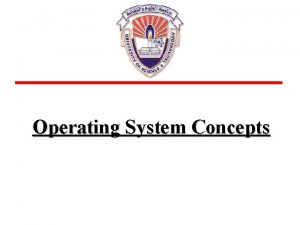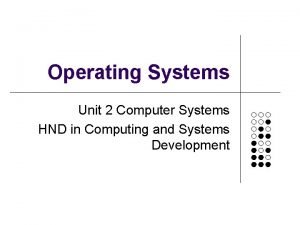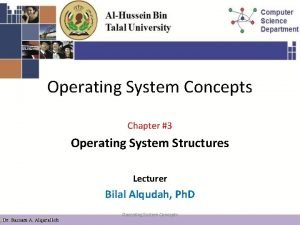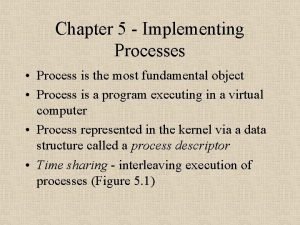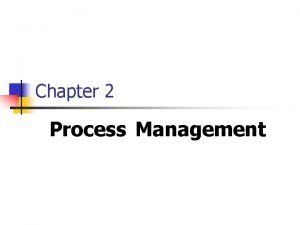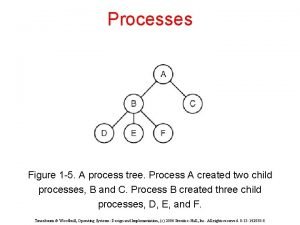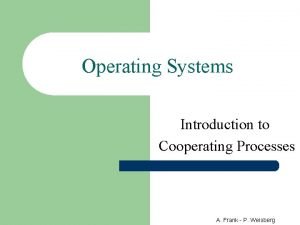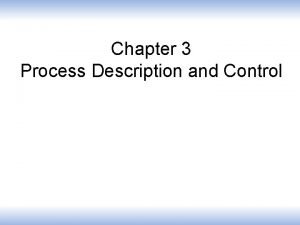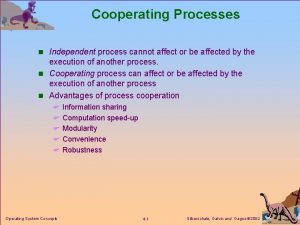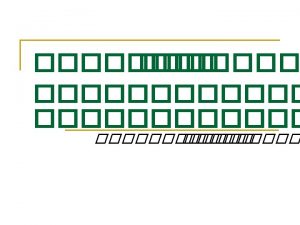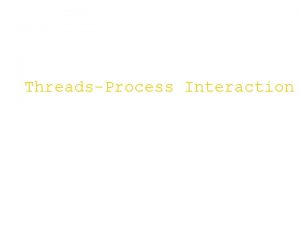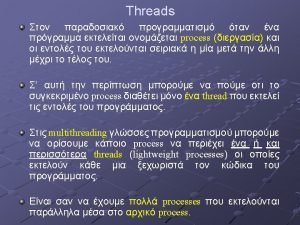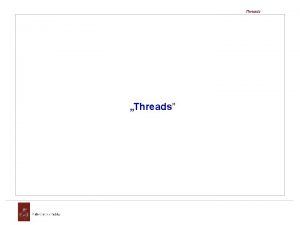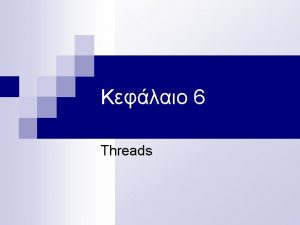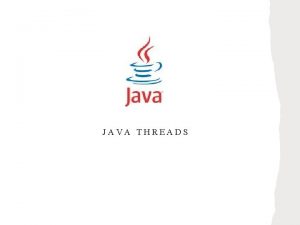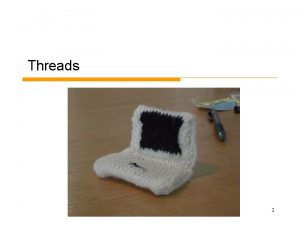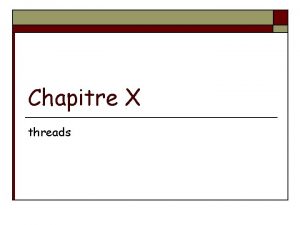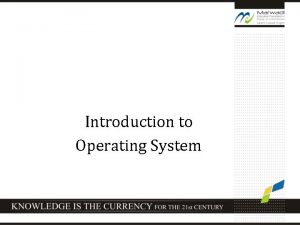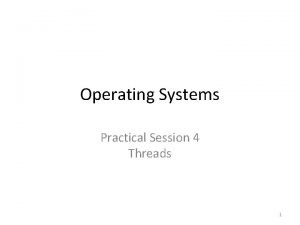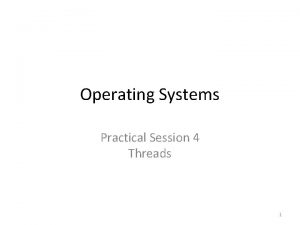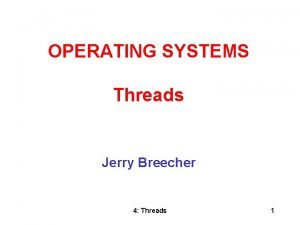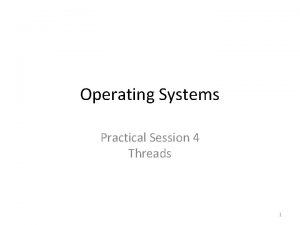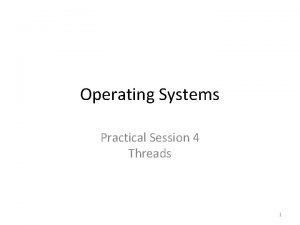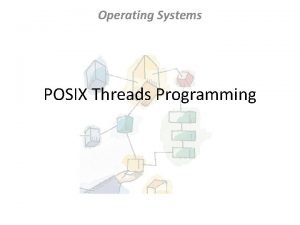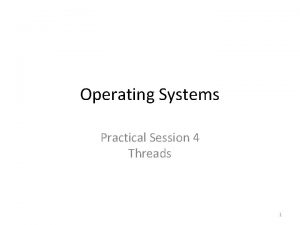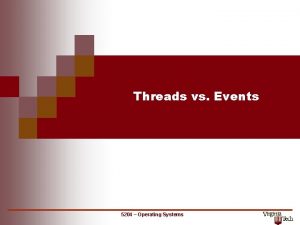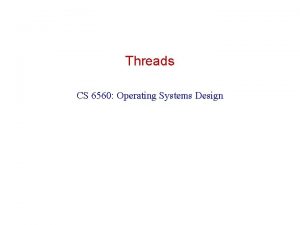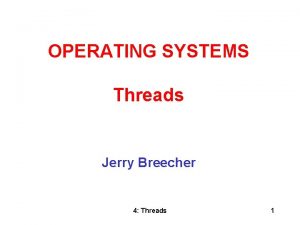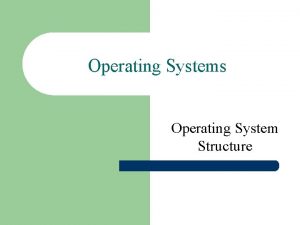OPERATING SYSTEM LESSON 5 THREADS THREADS The process



























- Slides: 27

OPERATING SYSTEM LESSON 5 THREADS

THREADS The process model is based on two independent concepts: resource grouping and execution. A process is the way to group related resources together. A process has an address space containing program text and data, as well as other resources. These resource may include open files, child processes, pending alarms, signal handlers, accounting information, and more. By putting them together in the form of a process, they can be managed simplier. 2

The other concept a process has is a thread of execution, usually shortened to just thread. The thread has a program counter that keeps track of which instruction to execute next. It has registers, which hold its current working variables. It has a stack, which contains the execution history, with one frame for each procedure called but not yet returned from. Processes are used to group resources together; threads are the entities scheduled for execution on the CPU. 3

The threads allow multiple executions to take place in the same process environment, have a large degree independence of one another. Having multiple threads running parallel in one process is analogous (similar) to having multiple processes running in parallel in one computer. Threads share a process’ s address space, open files, and other resources whereas Processes share physical memory, disks, printers, and other resources. Because threads have some of the properties of processes, they are sometimes called lightweight processes. The term multithreading is also used to describe the situation of allowing multiple threads in the same process. 4

In following Fig. (a) we see three traditional processes. Each process has its own address space and a single thread of control. In contrast, in Fig. (b) we see a single process with three threads of control. Although in both cases we have threads, in Fig. (a) each of them operates in a different address space, whereas in Fig. (b) all three of them share the same address space. 5

Multithreading works the same way with multiprogramming. The CPU switches rapidly back and forth among the threads providing the illusion that the threads are running in parallel. 6

All threads have exactly the same address space, which means that they also share the same global variables. Because every thread can access every memory address within the process’ address space, one thread can read, write, or even completely wipe out another thread’s stack. Unlike processes, threads cooperate, not fight. In addition to sharing an address space, all the threads share the same set of open files, child processes, alarms, and signals, etc. As shown in following figure. 7

Like a traditional process, a thread can be in any one of several states: running, blocked, ready, or terminated. 8

Each thread has its own stack, as shown in following fig. Each thread’s stack contains one frame for each procedure called but not yet returned from. This frame contains the procedure’s local variables and the return address to use when the procedure call has finished. Each thread will generally call different procedures, thus a different execution history. This is why the thread needs its own stack. 9

When multithreading is present, processes normally start with a single thread. This thread has the ability to create new threads by calling a library procedure, for example, thread_create. A parameter to thread_create typically specifies the name of a procedure for the new thread to run. When a thread has finished its work, it can exit by calling a library procedure, say, thread_exit. It then vanishes and is no longer schedulable. Another common thread call is thread_yield, which allows a thread to voluntarily give up the CPU to let another thread run. 10

11

12

THREAD USAGE The main reason for having threads is that in many applications, multiple activities are going on at once. Some of these may block from time to time. By decomposing such an application into multiple sequential threads that run in quasi-parallel, the programming model becomes simpler. Why anyone wants use them? 1. The ability for the parallel entities to share an address space and all of its data among themselves. This ability is essential for some applications, which for having multiple processes (with their separate address spaces) will not work. 2. Becasuse threads do not have any resources attached to them, they are easier to create and destroy than processes. In many systems, creating a thread goes 100 times faster than creating a process. 3. Threads yield no performance gain when all of them are CPU bound, but when there is substantial computing and also substantial I/O, having these activities overlap, thus speeding up the operation. Threads are useful on systems with multiple CPUs, where real parallelism is possible 13

SOME EXAMPLES As a first example, consider a word processor. Most word processors display the document being created on the screen formatted exactly as it will appear on the printed page. Now consider what happens when the user suddenly deletes one sentence from page 1 of an 800 -page document. The user now wants to make another change on page 600 and types in a command telling the word processor to go to that page. The word processor is now forced to reformat the entire book up to page 600. Because it doesn’t know what the first line of page 600 will be until it has processed all the previous pages. There may be a substantial delay before page 600 can be displayed, leading to an unhappy user. 14

Threads can help here. Suppose that the word processor is written as a two-threaded program. One thread interacts with the user and the other handles reformatting in the background. As soon as the sentence is deleted from page 1 the interactive thread tells the reformatting thread to reformat the whole book. Meanwhile, the interactive thread continues to listen to the keyboard and mouse and responds to simple commands like scrolling page 1 while the other thread is computing madly in the background. 15

Many word processors have a feature of automatically saving the entire file to disk every few minutes to protect the user against losing data in the event of a program crash, system crash, or power failure. The third thread can handle the disk backups without interfering with the other two. The first thread just interacts with the user. The second thread reformats the document when told to. The third thread writes the contents of RAM to disk periodically. If the program were single-threaded, what would happen? 16

Now consider another example of where threads are useful: a server for a World Wide Web site. Requests for pages come in and the requested page is sent back to the client. Here one thread, the dispatcher, reads incoming requests for work from the network. After examining the request, it chooses an idle worker thread and hands it the request, The dispatcher then wakes up the sleeping worker, moving it from blocked state to ready state. 17

A third example where threads are useful is in applications that must process very large amounts of data. The normal approach is to read in a block of data, process it, and then write it out again. Threads offer a solution. The process could be structured with an input thread, a processing thread, and an output thread. The input threads data into an input buffer. The processing thread takes data out of the input buffer, processes them, and puts the results in an output buffer. The output buffer writes these results back to disk. In this way, input, output, and processing can all be going on at the same time. 18

IMPLEMENTING THREADS IN USER SPACE There are two main ways to implement a threads package: in user space and in the kernel. A hybrid implementation is also possible. The first method is to put the threads package entirely in user space. The kernel knows nothing about them. Kernel proceed it as managing ordinary, single-threaded processes. The first, and most obvious, advantage is that a userlevel threads package can be implemented on an operating system that does not support threads. 19

The threads run on top of a run-time system, which is a collection of procedures that manage threads. We have seen four of these already: thread_create, thread_exit, thread_wait, and thread_yield, but usually there are more. When threads are managed in user space, each process needs its own private thread table to keep track of the threads in that process. This table is analogous to the kernel’s process table, except that it keeps track of per thread’s program counter, stack pointer, registers, state, etc. h The thread table is managed by the runtime system. When a thread is moved to ready state or blocked state, the information needed to restart it is stored in the thread table, exactly the same way as the kernel stores information about processes in the process table. 20

When a thread does something that may cause it to become blocked locally, it calls a run-time system procedure. This procedure checks to see if the thread must be put into blocked state. If so, it stores the thread’s registers in the thread table, looks for a ready thread to run and reloads the machine registers with the new thread’s saved values. After the stack pointer and program counter have been switched, the new thread starts automatically. Doing thread switching like this is faster than trapping to the kernel. 21

When a thread is finished running for the moment, for example, when it calls thread_yield, the code of thread_yield can save thread’s information in the thread table itself. Furthermore, it can then call the thread scheduler to pick another thread to run. The procedure that saves the thread’s state and the scheduler are just local procedures, so invoking them is much more efficient than making a kernel call. Among other issues, no trap is needed, no context switch is needed, the memory cache need not be flushed, and so on. This makes thread scheduling very fast. 22

IMPLEMENTING THREADS IN THE KERNEL Kernel know about and manage threads. No run-time system is needed in each, as shown in following figure. Also, there is no thread table in each process. Instead, the kernel has a thread table that keeps track of all the threads in the system. When a thread wants to create a new thread or destroy an existing thread, it makes a kernel call, which then does the creation or destruction by updating the kernel thread table. 23

The kernel’s thread table holds each thread’s registers, state, and other information. The information is the same as with user-level threads, but it is now in the kernel instead of in user space (inside the run-time system). This information is a subset of the information that traditional kernels maintain about each of their single-threaded processes, that is, the process state. In addition, the kernel also maintains the traditional process table to keep track of processes. 24

Threads are blocked via system calls, at considerably greater cost than a call to a run-time system procedure. When a thread blocks, the kernel can run either another thread from the same process or a thread from a different process. With user-level threads, the run-time system keeps running threads from its own process until the kernel takes the CPU away from it (or there are no ready threads left to run). Their main disadvantage is that the cost of a system call is substantial, so if thread operations (creation, termination, etc. ) are common, much more overhead will occur. 25

HYBRID IMPLEMENTATIONS Various ways have been investigated to try to combine the advantages of user-level threads with kernel-level threads. One way is use kernel-level threads and then multiplex user-level threads onto some or all of the kernel threads. 26

In this design, the kernel is aware of only the kernellevel threads and schedules those. Some of those threads may have multiple user-level threads multiplexed on top of them. These user-level threads are created, destroyed, and scheduled just like userlevel threads in a process that runs on an operating system without multithreading capability. In this model, each kernel-level thread has some set of user -level threads that take turns using it. 27
 Slidetodoc.com
Slidetodoc.com Process and threads
Process and threads Process and threads
Process and threads Operating system lesson plan
Operating system lesson plan Process management in operating system
Process management in operating system Process management in operating system
Process management in operating system Implementation of process in operating system
Implementation of process in operating system Process management in operating system
Process management in operating system What is a process tree
What is a process tree Cooperating process in operating system
Cooperating process in operating system Process description and control in operating system
Process description and control in operating system Cooperating processes in os
Cooperating processes in os Buddy system example
Buddy system example File system in operating system
File system in operating system File system in operating system
File system in operating system File system in operating system
File system in operating system Lesson 2 muscle storyboard
Lesson 2 muscle storyboard Hình ảnh bộ gõ cơ thể búng tay
Hình ảnh bộ gõ cơ thể búng tay Ng-html
Ng-html Bổ thể
Bổ thể Tỉ lệ cơ thể trẻ em
Tỉ lệ cơ thể trẻ em Chó sói
Chó sói Tư thế worm breton
Tư thế worm breton Chúa yêu trần thế alleluia
Chúa yêu trần thế alleluia Các môn thể thao bắt đầu bằng tiếng nhảy
Các môn thể thao bắt đầu bằng tiếng nhảy Thế nào là hệ số cao nhất
Thế nào là hệ số cao nhất Các châu lục và đại dương trên thế giới
Các châu lục và đại dương trên thế giới Cong thức tính động năng
Cong thức tính động năng
